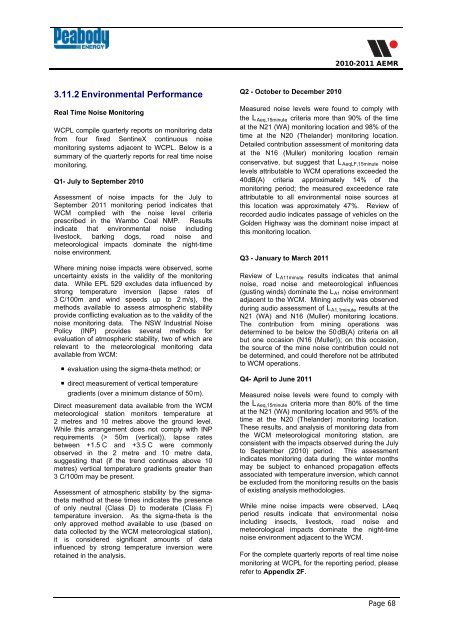Wambo Coal AEMR 2010-2011 - Peabody Energy
Wambo Coal AEMR 2010-2011 - Peabody Energy
Wambo Coal AEMR 2010-2011 - Peabody Energy
You also want an ePaper? Increase the reach of your titles
YUMPU automatically turns print PDFs into web optimized ePapers that Google loves.
<strong>2010</strong>-<strong>2011</strong> <strong>AEMR</strong>3.11.2 Environmental PerformanceReal Time Noise MonitoringWCPL compile quarterly reports on monitoring datafrom four fixed SentineX continuous noisemonitoring systems adjacent to WCPL. Below is asummary of the quarterly reports for real time noisemonitoring.Q1- July to September <strong>2010</strong>Assessment of noise impacts for the July toSeptember <strong>2011</strong> monitoring period indicates thatWCM complied with the noise level criteriaprescribed in the <strong>Wambo</strong> <strong>Coal</strong> NMP. Resultsindicate that environmental noise includinglivestock, barking dogs, road noise andmeteorological impacts dominate the night-timenoise environment.Where mining noise impacts were observed, someuncertainty exists in the validity of the monitoringdata. While EPL 529 excludes data influenced bystrong temperature inversion (lapse rates of3 C/100m and wind speeds up to 2 m/s), themethods available to assess atmospheric stabilityprovide conflicting evaluation as to the validity of thenoise monitoring data. The NSW Industrial NoisePolicy (INP) provides several methods forevaluation of atmospheric stability, two of which arerelevant to the meteorological monitoring dataavailable from WCM:• evaluation using the sigma-theta method; or• direct measurement of vertical temperaturegradients (over a minimum distance of 50 m).Direct measurement data available from the WCMmeteorological station monitors temperature at2 metres and 10 metres above the ground level.While this arrangement does not comply with INPrequirements (> 50m (vertical)), lapse ratesbetween +1.5 C and +3.5 C were commonlyobserved in the 2 metre and 10 metre data,suggesting that (if the trend continues above 10metres) vertical temperature gradients greater than3 C/100m may be present.Assessment of atmospheric stability by the sigmathetamethod at these times indicates the presenceof only neutral (Class D) to moderate (Class F)temperature inversion. As the sigma-theta is theonly approved method available to use (based ondata collected by the WCM meteorological station),it is considered significant amounts of datainfluenced by strong temperature inversion wereretained in the analysis.Q2 - October to December <strong>2010</strong>Measured noise levels were found to comply withthe L Aeq,15minute criteria more than 90% of the timeat the N21 (WA) monitoring location and 98% of thetime at the N20 (Thelander) monitoring location.Detailed contribution assessment of monitoring dataat the N16 (Muller) monitoring location remainconservative, but suggest that L AeqLF,15minute noiselevels attributable to WCM operations exceeded the40dB(A) criteria approximately 14% of themonitoring period; the measured exceedence rateattributable to all environmental noise sources atthis location was approximately 47%. Review ofrecorded audio indicates passage of vehicles on theGolden Highway was the dominant noise impact atthis monitoring location.Q3 - January to March <strong>2011</strong>Review of L A11minute results indicates that animalnoise, road noise and meteorological influences(gusting winds) dominate the L A1 noise environmentadjacent to the WCM. Mining activity was observedduring audio assessment of L A1,1minute results at theN21 (WA) and N16 (Muller) monitoring locations.The contribution from mining operations wasdetermined to be below the 50 dB(A) criteria on allbut one occasion (N16 (Muller)); on this occasion,the source of the mine noise contribution could notbe determined, and could therefore not be attributedto WCM operations.Q4- April to June <strong>2011</strong>Measured noise levels were found to comply withthe L Aeq,15minute criteria more than 80% of the timeat the N21 (WA) monitoring location and 95% of thetime at the N20 (Thelander) monitoring location.These results, and analysis of monitoring data fromthe WCM meteorological monitoring station, areconsistent with the impacts observed during the Julyto September (<strong>2010</strong>) period. This assessmentindicates monitoring data during the winter monthsmay be subject to enhanced propagation effectsassociated with temperature inversion, which cannotbe excluded from the monitoring results on the basisof existing analysis methodologies.While mine noise impacts were observed, LAeqperiod results indicate that environmental noiseincluding insects, livestock, road noise andmeteorological impacts dominate the night-timenoise environment adjacent to the WCM.For the complete quarterly reports of real time noisemonitoring at WCPL for the reporting period, pleaserefer to Appendix 2F.Page 68
















